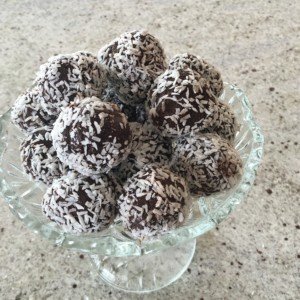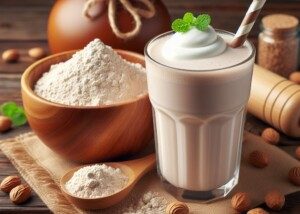
STEVIA Raw Chocolate Coconut Balls Simple Recipe
You will need:
– 12 level tablespoons almond meal (not “ground almonds,” but meal; this is very finely ground almonds)
– 8 level tablespoons coconut shreds
– 8 level tablespoons raw cacao powder
– 6 level tablespoons coconut oil
– 3 organic Medjool dates, pitted
– 8 packets Stevia (SweetLeaf brand; yes, it makes a difference)
– One-quarter teaspoon pure vanilla extract
One of the things that makes this recipe for Stevia raw chocolate coconut balls so unique is that it doesn’t require that many dates.
Other recipes on the ‘Net call for a lot of dates relative to other ingredients, and as a result, the balls end up tasting “datey” or even like cornflakes.
Instructions for Stevia Raw Chocolate Coconut Balls
In a big bowl, put all the dry ingredients first. A “level” tablespoon is literally level, not heaping.
To make it level, scoop up enough of the dry ingredients so that the spoon is heaping.
Then with a butter knife, skim it across the rim of the spoon (and please, use a standard measuring spoon, not a soup spoon).
The purpose of heaping the spoon is to make sure no air pockets are formed when you skim. In fact, skim by “bouncing” the knife as you go.
After the dry ingredients, put in the coconut oil (never refrigerate; not necessary; it has an extremely long, if not indefinite, shelf life as long as it’s securely sealed).
If you put the coconut oil in before the dry ingredients, the dry ingredients will stick to the spoon—unless you don’t mind cleaning up the spoon first.
With a butter knife, scoop out the oil (assuming it’s solid; it liquefies if room temperature is 76 degrees) and stuff into the tablespoon, then skim the surface.
Make sure there are no air pockets. Skim really good so that the surface of the oil is flush or even with the rim of the spoon. With butter knife, then dig it out thoroughly and put in the bowl.
Add the Stevia. I’ve tried other brands of Stevia, and trust me, SweetLeaf is the best. The other brands are bland and don’t do much for sweetening.
Add the vanilla extract.
With a food processor, grind up the dates. IMPORTANT: Grind up so that the end product has almost the consistency of peanut butter, in that it’s spreadable.
It doesn’t have to be creamy smooth, but almost so. If there’s a chunky-particle appearance to it, it needs more processing.
Add this spreadable date goop to the bowl.
With a sturdy steel or wooden mixing spoon, mix everything by aggressively pressing the bottom of the spoon, from the edge of the bowl towards the center, rotating the bowl with the other hand.
If your food processor can handle mixing all the ingredients, then process the dates first (so that you can visually confirm spreadability), then add the remaining ingredients. My food processor can’t handle powder; it jams the blades.
But if you’re mixing in a bowl by hand (electric mixers won’t work), you must be patient and aggressive; it takes some elbow grease.
Just keep furiously mixing, and you’ll note that the clumps of coconut oil and dates will NOT be evenly distributed.
Press on these with the spoon to further break them down and distribute them throughout the dry mix. You don’t want any one ball to have a large clump of just date or coconut oil in it.
Keep mixing till it looks like everything is evenly distributed, no isolated clumps of date goop or coconut oil.
IMPORTANT: The final mixture will appear too dry to form into balls. Do NOT add anything. If you add even another one-quarter tsp of vanilla, the balls may be too sticky.
Grab enough of the mix to make a ball, and squeeze in your palm to compact it first, then mold into a sphere between two rotating palms, a ball.
With fingers, first compact the mix a little, then begin rolling—and use enough mix to make balls almost the size of a ping pong ball.
This recipe makes 12 balls, depending on the size you roll them.
Again, the mix will appear too dry to mold into balls, but it will mold very nicely and they will hold in place.
If you want the balls to be sticky enough to roll in coconut shreds, almond meal or chia seeds, add another quarter teaspoon of vanilla. If this doesn’t quite do it, add another quarter teaspoon.]
Once nicely molded, place on a plate and refrigerate for later on if you prefer them cold, but they taste just divine at room temperature.
In fact, when refrigerated, these Stevia raw chocolate coconut balls take on a denser quality, but at room temperature, have a consistency resembling non-refrigerated squares of fudge.
These Stevia raw chocolate coconut balls are SUPER good for your body! And doggone it, you won’t believe how great they taste!














